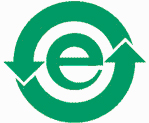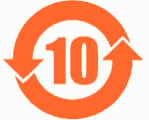WatchGuard Technologies strives, within our functional requirements, to minimize the environmental impact of our products by:
- Carefully designing and selecting appliance and packaging material that are recyclable
Designing appliances that use as little energy as possible
Minimizing materials by focusing appliance functionality and media
Design for Environment (DfE) has become an increasingly important dimension of environmental management for WatchGuard. Enacted and proposed collection and treatment policies (WEEE), Restriction of Hazardous Substances (RoHS) policies in Europe and Asia, recycle-oriented eco-label requirements, and increasing environmental awareness have all prompted the electronics industry to continuously improve the recyclability of its product designs. Designing network firewall appliances that minimize overall environmental impact and are recyclable has therefore come to be viewed not only as environmentally beneficial, but also as a strategic business requirement for WatchGuard.
To that end, WatchGuard continues to dedicate resources and implement policies to ensure that the products we sell minimize overall environmental impacts. We achieve this by creating designs that reduce material usage and waste, increase recyclability, lengthen life cycles, and minimize energy consumption in all aspects of their distribution and operation. Read more about recyclable products from WatchGuard. [541kb PDF]
RoHS: EU Directive 2002/95/EU
WatchGuard Technologies is committed to eliminating environmentally hazardous substances from our products as defined in the current EU's RoHS Directive. WatchGuard management is firmly committed to this task, and has established policies and dedicated resources to ensure compliance in a complete and timely manner.
The RoHS Directive restricts the use of certain substances (lead, mercury, cadmium, hexavalent chromium and two flame retardants - PBB and PBDE) in electrical and electronic products sold in the European Union after July 1, 2006, and WatchGuard Technologies' e-Series products are fully compliant as of that date.
Reduction of Hazardous Substances Frequently Asked Questions
Q: What is RoHS?
A: RoHS is the acronym used to refer to the European Union (EU) Directive 2002/95/EC on the Restriction of the use of certain hazardous substances in electrical and electronic equipment.
Q: What are the RoHS listed substances?
A: There are six (6) RoHS substances: lead (Pb), cadmium (Cd), mercury (Hg), hexavalent chromium (Cr+6), polybrominated biphenyls (PBB) and polybrominated diphenylethers (PBDE).
Q: Is the RoHS Directive only applicable to products sold into the European Union?
A: Yes, however other countries are drafting RoHS-type legislation and WatchGuard anticipates similar regulations may eventually be adopted worldwide.
Q: When is WatchGuard's RoHS compliance implementation date for its products?
A: WatchGuard's RoHS compliance implementation deadline is 1st July 2006. Our e-Series product's will be available prior to July 1, 2006.
Q: Can WatchGuard provide companies with RoHS and non-RoHS material content and use information?
A: All of WatchGuard’s products sold after July 1, 2006 are RoHS compliant. We can provide RoHS Certificate of Compliance for all our current products.
Q: What is WatchGuard's strategy for service replacement of equipment?
A: WatchGuard's service offerings in the EU will meet all requirements of the RoHS Directive, including the use of exemptions that specifically apply to repair or replacement and reuse of equipment. In addition, non-RoHS products placed on the EU Market prior to 1 July 2006 are allowed to be maintained with non-RoHS replacement parts. WatchGuard will continue to service non-RoHS equipment; there will be no changes to existing our current service agreements.
WEEE: EU Directive 2002/96/EU
WEEE Statement
WEEE Statement
WatchGuard is working in partnership with our European Union (EU) distribution partners to ensure that our products are in compliance with the WEEE statutes, and that the recovery of our product per the specific EU country legislative requirements is seamless for our product's end users. If you have a WatchGuard product that is at its end of life and needs to be disposed of, please contact WatchGuard Customer Care Department at:
U.S. Customers: 877.232.3531
International Customers: +1.206.613.0456
WatchGuard is reasonably confident that our products do not contain any substances or hazardous materials presently banned by any legislation, and do not present a risk due to hazardous materials. WEEE recovery professionals should also note that these products do not have any materials that are of particular high value in their individual form.
WEEE Symbol Explanation
 WEEE Notice
WEEE Notice
The WEEE symbol on your WatchGuard equipment indicates that it should be disposed of by the end user in a manner consistent with required EU Directives, and the local transposition of the Directive in the end user's jurisdiction. The symbol is placed per Annex IV of the Directive and as prescribed by CENELEC standard EN50419, dated December 7th, 2004.
Frequently Asked Questions
Q: Who do I contact in regard to disposal and recovery of my appliance per the WEEE statutes in my country?
A: WatchGuard made an agreement with our distributors and resellers to take back any WatchGuard product for recycling.
Q: What is WEEE and what does the WEEE symbol ("wheelie bin") on my appliance mean?
A: WEEE is a general set of requirements dictated in the EU Directive 2002/96/EC. This Directive mandates that member EU countries enact regulations governing the Waste of Electrical and Electronic Equipment (WEEE). The Directive, and its individual transpositions into specific country laws and legislation, is aimed at the reduction of WEEE through reuse, recovery, and recycling of WEEE.
The WEEE symbol on WatchGuard appliances means that the product was placed on the market after August 13, 2005, and must be treated as "new" WEEE. All appliances placed on the market prior to August 13 do not have the WEEE symbol and should be treated as "old" WEEE. Each EU country's legislation mandates that "old" and "new" WEEE be treated differently, and specific requirements may vary based on each country's enacted legislation.
Q: What does it mean if I have a WatchGuard appliance that does not have a WEEE symbol ("wheelie bin") on it?
A: Prior to July 1, 2006 WatchGuard products were not required to have a WEEE symbol. Products introduced to sale after that date are RoHS compliant and a Certificate of Compliance for all of our current products can be provided.
Q: I do not know who I purchased my WatchGuard security appliance from, and need to dispose of the appliance per WEEE regulations in my country. Who do I contact to find out how to dispose of my appliance?
A: WatchGuard can most likely provide you with the distributor or reseller who sold you your appliance. If not we can provide you with the distributor or reseller nearest you who can dispose of your appliance properly. Please contact a WatchGuard Customer Care representative, who will be able to provide information to you regarding your appliance's recovery. Please have your appliance's serial number available when you contact your Customer Care representative. It can be found on either the back or bottom of your appliance. A Customer Care representative can be reached at:
-
U.S. Customers: 877.232.3531
International Customers: +1.206.613.0456
RoHS: China Directive
China has enacted legislation more commonly known as "China RoHS" which will have an effect on the reporting and restriction of hazardous materials in products that are shipped to China with the intention of selling them within the country. As of March 1, 2007, all Electronic Information Products (EIP) going to China are to be labeled with China-specified labels indicating the presence of hazardous materials above or below the Maximum Concentration Value (MCV) limit. In addition, China RoHS requires appropriate recycle symbol markings on the outer boxes of products shipped into China with the intention of selling the products within the country. WatchGuard Technologies’ Firebox® X e-Series products comply with this Chinese regulation.
China RoHS Symbols Explanation
 This symbol indicates that the product does not contain any materials at the homogeneous level with any of the restricted hazardous substances over the MCV limit. This symbol applies to all Firebox® X Edge e-Series appliances.
This symbol indicates that the product does not contain any materials at the homogeneous level with any of the restricted hazardous substances over the MCV limit. This symbol applies to all Firebox® X Edge e-Series appliances.
 This symbol indicates that the product contains at least one homogeneous material with at least one of the restricted hazardous substances over the MCV limit. This symbol must be accompanied by a Hazardous Materials table in the product literature. This symbol applies to the Firebox® X Core™ and Firebox ® Peak™ e-series products, as they contain a part that is an exemption under the European Union RoHS directive but not under the Chinese regulation.
This symbol indicates that the product contains at least one homogeneous material with at least one of the restricted hazardous substances over the MCV limit. This symbol must be accompanied by a Hazardous Materials table in the product literature. This symbol applies to the Firebox® X Core™ and Firebox ® Peak™ e-series products, as they contain a part that is an exemption under the European Union RoHS directive but not under the Chinese regulation.
Frequently Asked Questions
Q: Are all WatchGuard products affected by China RoHS?
A: All WatchGuard products are classified by the China RoHS directive as Electronix Information Products (EIP) and are therefore affected by China RoHS.
Q: When will WatchGuard products be compliant with China RoHS?
A: All products manufactured after March 1, 2007 will be compliant with the China RoHS legislation, guidance, and FAQ as issued by the Chinese Ministry of Information Industry (MII) on December 1, 2006.
Q: Will there be any change to WatchGuard part numbers as a result of China RoHS?
A: No. There will be no changes to existing product part numbers. Customers may continue to order products just as they have in the past. All products shipping after March 1, 2007 will comply with China RoHS requirements without any special action on the part of our customers.
Q: Does WatchGuard plan to End-of Sale (EOS)/End-of-Life (EOL) any products as a result of China RoHS?
A: No.
Q: Are there any changes to WatchGuard’s Return Merchandise Agreement (RMA) policies or procedures as a result of China RoHS?
A: No. RMA procedures and requirements will not change as a result of China RoHS.
WEEE Recyclers Information Datasheet
Environmental Legislation Compliance